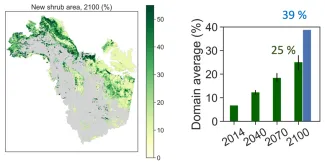Not considering dispersal and fire leads to overestimating shrub expansion in Arctic tundra and its role as a carbon sink.
Observational studies and models typically use relationships between observed shrub presence and current environmental suitability (bioclimate and topography) to predict shrub expansion. Such approaches omit shrub demographic processes and nonstationary response to changing climate. Here, the team used high-resolution satellite imagery across Alaska and western Canada to analyze the spatial pattern of shrub expansion from 1984 to 2014. The team built species distribution models to estimate environmental suitability of shrubs and quantify seed arrival probability using spatial proximity to existing shrub patches. The results show that while suitability explained shrub distribution in 1984, it has not been controlling shrub expansion during 1984–2014, which can only be explained by considering seed dispersal and fire. These findings provide the motivation for better observations of recruitment and for incorporating currently underrepresented processes of seed dispersal and fire in land models to project shrub expansion and climate feedbacks. The team further integrated these dynamic processes with projected fire extent and climate to predict shrub expansion. The results suggest that shrubs will expand into 25% of the non-shrub tundra by 2100, in contrast to 39% predicted based on increasing environmental suitability alone. Thus, using environmental suitability alone likely overestimates and misrepresents shrub expansion pattern and its associated carbon sink.
Citation: Yanlan, L. , W. J. Riley, T. F. Keenan, Z. A. Mekonnen, J. A. Holm, Q. Zhu, and M. S. Torn. 2022. “Dispersal and fire limit Arctic shrub expansion.” Nature Communications 13: 3843. https://doi.org/10.1038/s41467-022-31597-6.
A quarter of non-woody tundra in 1984 will be colonized by shrubs by 2100 based on the climate scenario RCP8.5. (left) Spatial pattern of new shrub area in 2100 predicted using environmental suitability, dispersal, and fire. (right) Domain averages of new shrub area predicted with (green bars) and without (blue bar) considering dispersal and fire. Using environmental suitability alone overestimates shrub expansion.


